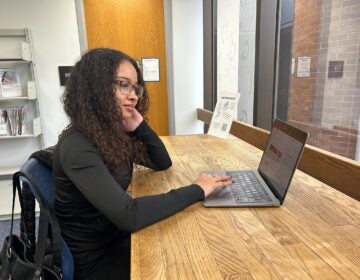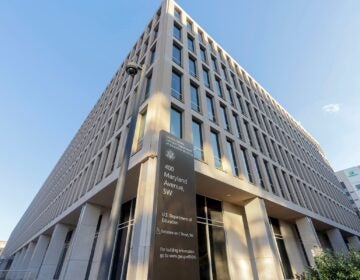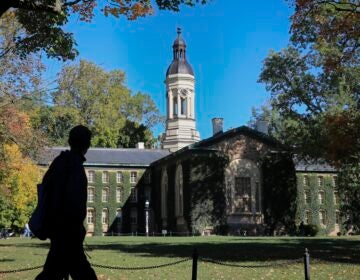With fewer foreign students taking intensive English classes, Philly universities pivot
Administrators of intensive English programs say a kaleidoscope of factors have contributed to the contraction — including the economy and the 'Trump factor.'
Listen 5:02-
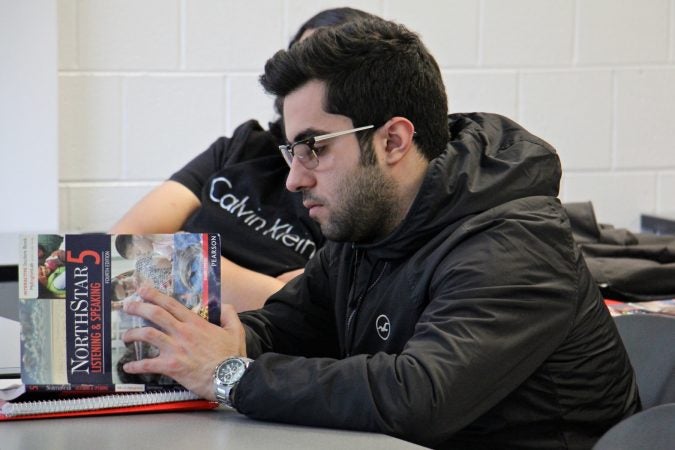
Ali Ashkanani of Kuwait opens his book during an intensive English class at Temple University. (Emma Lee/WHYY)
-

Students split into small discussion groups during an intensive Englisht course for international students at Temple University. (Emma Lee/WHYY)
-

Ann Draemel engages her students in conversation during an intensive English course for international students at Temple University. (Emma Lee/WHYY)
-
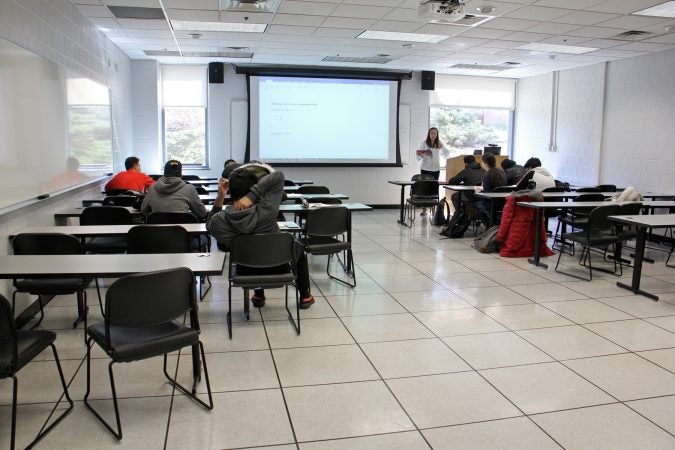
Ann Draemel teaches 10 students in a college level English course for international students at Temple University. Demand for the course has dropped along with international enrollment. (Emma Lee/WHYY)
Ali Ashkanani started studying English in elementary school in Kuwait, more than 6,000 miles away from where he now lives in Philadelphia.
Coming here, he said he found gaps in his language skills he couldn’t recognize before. For example: pronunciation. Simple phrases learned by rote in Kuwait sounded completely different on the lips of native English speakers.
“In our country we say, ‘bottle of water,’ ” he said, shortening the vowels and pronouncing a hard ‘t’ in both words. “But here, you should say ‘boddle of wooder,’ ” he said, mimicking the confident slur of a Philadelphian. To bridge those gaps, Ashkanani, 19, began an intensive English program at Temple University seven months ago.
For the 2016-2017 school year, more than a million students from abroad came to take higher education courses in the United States, injecting billions of dollars into the economy and supporting hundreds of thousands of jobs, according to Open Doors, a group that tracks international student enrollment for the U.S. Department of State.
In many cases, those students need to perfect their English before moving into a degree-granting program, leading to a boom in intensive English language programs in the Philadelphia area. After a period of rapid growth, those programs and the English-teaching jobs they support have declined sharply in the last couple of years.
Ann Draemel, Ashkanani’s instructor in Advanced Listening and Speaking 1, said when she first started working at Temple in 2013, many of her classes had more than 20 students. Now, the smallest has fewer than 10 students.
“It makes the classes interesting. I kind of prefer them to be smaller, but it’s also a little bit alarming,” said Draemel.
That story — of intensive English language classes shrinking by half — echoes around the region and across the country.
“Language programs, the majority of them, are experiencing decreases in enrollment,” said Cheryl Delk Le Good, executive director of English USA, a trade association for intensive English programs. Enrollment in intensive English language programs shrank by 26 percent last year — part of an overall flattening in international enrollment, according to Open Doors.
Administrators of intensive English programs say a kaleidoscope of factors have contributed to the contraction.
“The dollar is so strong right now in the States … it makes it much more expensive to come,” said Delk Le Good. English programs in other English-speaking countries, such as Australia and Canada, are more affordable — and perhaps more attractive — as a result.
Countries including Saudi Arabia and Brazil, which spent big on scholarships for their students to study abroad, have also cut back in recent years.
“There was kind of a bubble” driven by those scholarships, said Jack Sullivan, the University of Pennsylvania’s English Language Programs director. At the peak of enrollment, around 2014, “we fought for more teachers and more classrooms, more teachers, more classrooms.”
After that growth, the current slump is even more pronounced. And now, there’s a new fear among administrators that another problem could drive even more students away. Reese Heitner, the interim director of Drexel University’s English Language Center, called it the “Trump factor.”
“International students have a different perception of being in the U.S. these days,” he said.
Taken together, these factors paint a bleak picture for Americans who teach international students. Down from a peak of more than 20 guest lecturers a few years ago, Drexel’s program has largely stopped hiring adjunct faculty, according to Heitner. Temple also reduced its staffing levels, while Sullivan said Penn has not replaced some of its staffers who have moved on to other work.
These changes, while abrupt, are not without new opportunities, according to university administrators.
“We’re shifting our focus to look at other types of programming where we’re seeing an increase in demand,” said Jacqueline McCafferty, the director of Temple University’s Intensive English Language Program. The university is expanding what are called conditional admission programs, which feed students directly from English language classes into undergraduate or graduate degree programs. At the University of Pennsylvania, English language courses that last a few weeks at a time, as opposed to several months, are on the rise.
Still, some program directors said they had concerns that the changing status of the United States on the world stage may be in part to blame for enrollment trending down. If that’s the case, Ali Ashkanani and his classmates betrayed no qualms about their choice to come to America to learn.
“The first few weeks I understood nothing in the classes,” he said. “I keep focusing. I want to learn, I want to read, and I improve myself bit by bit.” Learning English in the U.S. and earning an American degree will make him more competitive in the Kuwaiti job market, he said.
Classmate Abeer Alharbi, 26, wants to earn a master’s degree in pharmacology before returning to Saudi Arabia to work. Many of the textbooks she used for her undergraduate degree were in English, she said, because they have not yet been translated into Arabic.
Studying in the United States also has provided her with a window to the world.
“When I came here, it’s like all the world in one place,” she said. “There’s a real diversity here, and I like that.”
WHYY is your source for fact-based, in-depth journalism and information. As a nonprofit organization, we rely on financial support from readers like you. Please give today.


